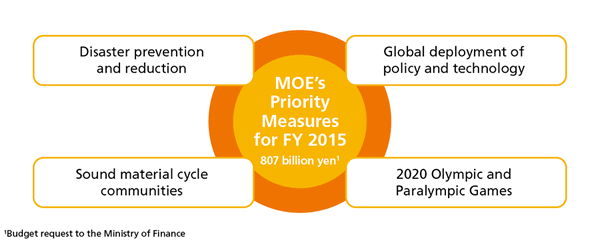Current topics
Efforts in Education for Sustainable Development (ESD)
Towards the UNESCO World Conference on ESD
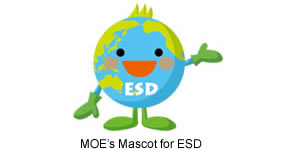
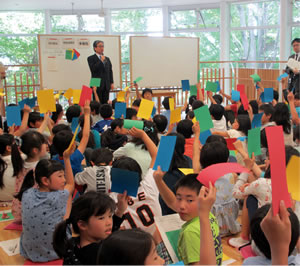
Parliamentary Senior Vice-Minister Mr. Kitagawa delivering an Environmental Education class titled "Diversity"
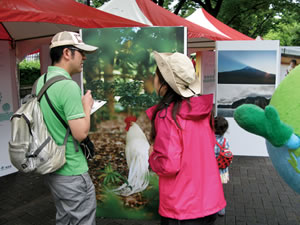
ESD Photo Communication Project
The "UNESCO World Conference*1 on ESD*2" is just around the corner. At the Ministry of the Environment (MOE), we are taking this opportunity to accelerate our efforts in ESD.
The MOE's main efforts in ESD are:
- The "Challenge Project for ESD Programs in the Tohoku Region" to build upon the earthquake reconstruction efforts in Tohoku to instigate new approaches to ESD and to disseminate these for implementation throughout Japan
- The "Capacity Building Project for Sustainable Regional Development" to pilot 20 publically chosen model ESD programs at primary and secondary schools in all prefectures, and then to expand them into regional programs
- Follow-up on the "United Nations Decade of ESD" by holding a round table discussion chaired by Mr. Kitagawa, Parliamentary Senior Vice-Minister of the Environment, to formulate a proposal of measures to promote Environmental Education.
MOE is also working on projects such as the "ESD Learning Forum: ESD KIDS FES!!!," the production of an Environmental Education Book by the "Tripartite Environmental Education Network among Japan, China and Korea," and the "ESD Photo Communication Project."
We look forward to disseminating these efforts of MOE at the UNESCO World Conference on ESD.
More Information:
*1 Conference overview: the government of Japan and UNESCO will co-host the ministerial-level UNESCO World Conference on ESD in Nagoya. Stakeholder meetings will be held in Okayama. Both meetings will be held in November 2014.
*2 Education for Sustainable Development (ESD): Education that aims for transformative behavior change towards a sustainable society based on the understanding that each one of us lives in relationship with people around the world, future generations, and the environment.
MOE's Priority Measures for Fisical Year 2015

The Ministry of the Environment (MOE) has announced the priorities of its budget request for fisical year 2015. The basic direction is to construct a society based on decentralized low-carbon energy, harmony with nature and sound material cycle. This will be done not only through environmental conservation measures, but also through measures to vitalize regional economies inspired by those conservation measures according to different natural environments and characteristics of the localities such as their urban- and rural-ness. More specifically, the following four elements comprise the main pillars of MOE's priorities for FY 2015.
The first pillar is disaster prevention and reduction based on the lessons from the Great East Japan Earthquake and subsequent reconstruction. MOE will work towards the speedy reconstruction and revitalization of areas affected by the 2011 earthquake by addressing environmental contamination by radioactive materials. It will also work on readying the nation for large-scale disasters in the future, assuming the occurrence of events such as earthquakes occurring directly beneath the Tokyo Metropolitan Area and Nankai Trough Mega-Earthquake.
Another pillar consists of the construction of new-generation local communities embracing a sound material cycle. MOE will work on the construction of local communities with a sound material-cycle by restoring natural cycles such as material, energy, secondary nature ("Satoyama," "Satoumi," etc.) and ecosystem cycles. Novel methodologies of environmental finance and community investment will be used for this. Simultaneously promoting environmental education, learning, and awareness will support the human development of individuals capable of creating such communities. Basic research on these measures will procure the foundation for the wellbeing of current and future generations.
The third pillar is the international deployment of Japan's successful environmental policy and technology in accordance with overseas demand. MOE will contribute to the construction of a sustainable global society through dialogues with key countries and intergovernmental organizations towards the establishment of a legal framework ensuring the effectiveness and transparency of measures against climate change. Early ratification of the Minamata Convention, through appropriate control of mercury within Japan and the provision of assistance to curb mercury pollution in developing countries, will also contribute to the construction of a sustainable society. We also hope to enable the leapfrog development of developing countries (mainly in the Asia-Pacific region) by transferring our advanced environmental technologies and fostering institutional and human resources development in ways suited to the respective context. Capturing the demand these measures create overseas will also facilitate Japan's economic development.
Efforts towards the 2020 Olympic and Paralympic Games in Tokyo make up the final pillar of MOE's measures in FY 2015. The environmental impact of these events will be minimized through e.g. introducing renewable energy, implementing the 3Rs, and smooth waste treatment. We will take this opportunity to disseminate our efforts to establish Tokyo as a top-tier "environmental city."
Strategy for Conservation of Endangered Species of Wild Fauna and Flora
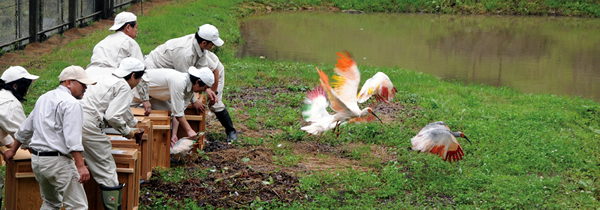
Transferring captive Japanese crested ibises to acclimation cages
In April 2014, the Ministry of the Environment (MOE) of Japan formulated the "Strategy for Conservation of Endangered Species of Wild Fauna and Flora." Based on the "National Biodiversity Strategy of Japan 2012-2020," the Strategy lays out Japan's basic approach to conservation and the progression of immediate measures to be taken.
More specifically, this Conservation Strategy clarified the prioritization of endangered species that require conservation measures. Conservation priority is to be determined through an assessment of: 1) the difficulty of the species' survival and 2) the effectiveness of measures. Measures indicated in the Strategy include the development of a "Conservation Catalogue of Endangered Species" to enhance the knowledge base on conservation and the goal to designate an additional 300 Domestic Endangered Species under the Law for the Conservation of Endangered Species of Wild Fauna and Flora by 2020.
The Aichi Target was adopted as a new set of global targets at the 10th Conference of the Parties (COP10) of the Convention on Biological Diversity that was held in Japan in 2010. Based on the above Strategy, we will coordinate and cooperate with a wide variety of entities to advance measures for the conservation of endangered species and to achieve the individual targets on endangered species in the Aichi Target. This April, we also established the new Office for Conservation of Endangered Species in the Nature Conservation Bureau to strengthen our organizational structure towards these aims. As such, we are hopeful about the enduring positive impact of the Strategy of Conservation.
More Information:
Endangeres wildlife in Japan
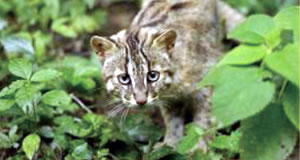
Tsushima leopard cat Critically endangered
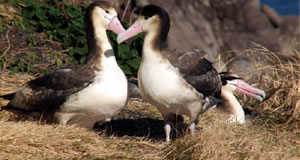
Short-tailed albatross Vulnerable
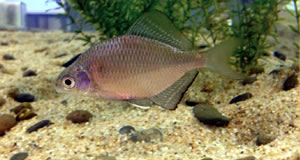
Deep-bodied bitterling Critically endangered
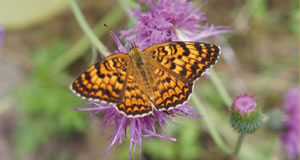
Melitaea scotosia Critically endangered
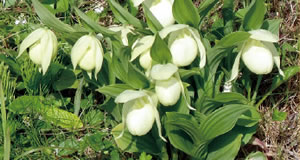
Slipper orchid Endangered
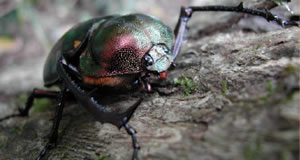
Cheirotonus jambar Endangered




